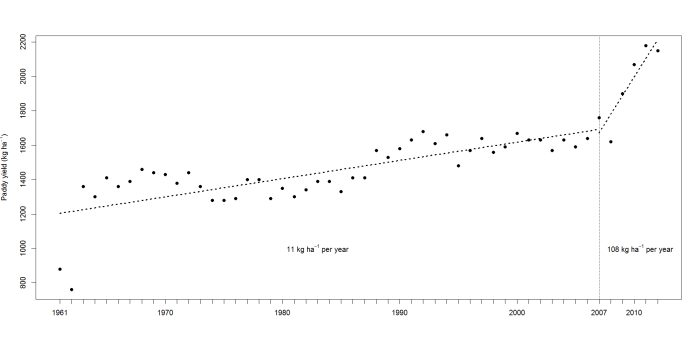Many countries in sub-Saharan Africa are keen to develop their rice sector — the continent imported 12 million tonnes of rice in 2012 alone, costing US$ 5 billion. I travelled to Côte d’Ivoire some months ago, and it is clear that this country is no exception.
I first paid a visit to the AfricaRice research facility in M’bé, near the town of Bouaké. These 700 ha grounds were abandoned in 2002 because of the civil war. A handful of extremely dedicated staff were able to maintain the infrastructure in excellent shape throughout the conflict. Offices and laboratories are generally empty but have been kept clean. Posters in the hallways reflect research done more than a decade ago. All the calendars are stuck on the month of September 2002; AfricaRice staff were evacuated from Bouaké on 26 September 2002. Time has really stood still here.
Fast-forward to 2013: more than 10 years later we are finally able to re-use our facility, at the moment mainly for foundation seed production — the demand for rice seed in Côte d’Ivoire is enormous. In 2012, we produced 124 tonnes of foundation seed of four popular varieties (WITA 9, WAB 56-50, WAB 638-1 and NERICA 1) and that was as much as we could do. Slowly we hope to re-start research activities at M’bé profiting from the fact that all the main rice-growing environments — upland, rainfed lowland and irrigated — are present within the 700 ha experimental farm.
In Abidjan on the way back our regional representative in Côte d’Ivoire, Amadou Bèye, organized a meeting with high-ranking officials of the Ministry of Agriculture and the Ministry of Higher Education and Scientific Research to look into the rice future. The meeting was attended, among others, by the directors general and support staff of Direction générale des productions et de la sécurité alimentaire (DGSPA), Office national pour le développement de la riziculture (ONDR), Fonds Interprofessionnel pour la Recherche et le Conseil Agricoles (FIRCA), Agence nationale d’appui au développement rural (ANADER), Centre national de recherche agronomique (CNRA) and the director general of scientific research and technological innovation of the Ministry of Higher Education and Scientific Research (who chaired the meeting) and representatives of the University Félix Houphouët-Boigny.
What emerged from the meeting is the highly ambitious objective of the Ivorian government to increase annual production to 1.9 million tonnes of milled rice of good quality by 2016, and 2.1 million tonnes of milled rice by 2018. At the projected 2018 level, the country would be able to start exporting rice. Rice development in the country is steered by an umbrella organization for the development of the rice sector, ONDR, headed by someone with a lot of private-sector experience, Mr Yacouba Dembélé.
ONDR has two main emphases: (1) technical support to rice production, and (2) technical support to value addition. Axis 1 comprises seed production, water management, mechanization of production and postharvest practices, improved crop management practices, and accompanying research and development activities. Axis 2 comprises marketing and labeling (‘Riz Côte d’Ivoire’), development of private-sector involvement, public–private partnerships, support to rice processing, and support to marketing of locally produced rice.
ONDR has divided Côte d’Ivoire into ‘rice pools’ of about 70 km2 each in the major rice-producing zones. The leader of each ‘pool’ is a rice processing unit operator. Funding for inputs (including seed) and purchase of paddy is channeled to farmers through these processing units. Rice millers steer the demand for seed and other inputs and pool paddy production. A combination of mini rice mills and medium-sized rice mills will be instrumental in pooling paddy rice from farmers. A total of 48 ‘pools’ have been identified with an average capacity of 37,500 tonnes of milled rice, giving a total of 1.8 Mt of milled rice. These ‘pools’ are distributed over 10 zones, each zone producing an average of 0.18 Mt of milled rice. The financing of the operators of ‘pools’ is done through banks, such as the West African Development Bank (BOAD) and the African Development Bank (AfDB). The performance of the ‘pools’ is monitored by ONDR agents, who are not involved in extension (which is left to ANADER); ONDR only monitors what is going on.
The estimated budget to realize these ambitions is about 477 billion FCFA (about US$ 1 billion), with funding coming from the private sector (64%), development partners (22%) and the state (14%).
Mr Dembélé highlighted the problem of lack of information with respect to rice knowledge and technology, in particular seed availability, and is keen to collaborate with AfricaRice and CNRA in that area.
The ‘pool’ approach is currently being tested with three rice mills in Gagnoa. The first results are very promising: these three mills have established contracts with farmers who deliver paddy with the help of ANADER, and contractual arrangements are being established between millers and farmers. An agreement on paddy price has been reached for the 2013 growing season and accepted by all rice farmers and millers in the entire Gagnoa region.
Mr Dembélé will talk about these exciting developments during the upcoming Third Africa Rice Congress in Yaoundé, Cameroon, scheduled for 21–24 October 2013. He left our meeting early to negotiate the purchase of rice mills with a capacity of 5 t per hour from India.

